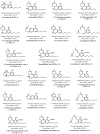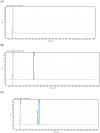High-Performance Liquid Chromatography with DAD Detection for the Determination of Cannabinoids in Commercial Veterinary CBD Oil
- PMID: 39728846
- PMCID: PMC11677526
- DOI: 10.3390/pharmacy12060181
High-Performance Liquid Chromatography with DAD Detection for the Determination of Cannabinoids in Commercial Veterinary CBD Oil
Abstract
The study highlights the need for quality control in evaluating medicinal plant products, especially CBD oils, before market release. Due to varying regulatory requirements, product labeling can sometimes be misleading, especially regarding cannabinoid concentrations such as CBD and THC. This research focused on developing a validated high-performance liquid chromatography (HPLC) method for accurately identifying and quantifying key cannabinoids in Commercial Veterinary CBD Oil. The main compounds identified included Cannabidivarin (CBDV), Cannabidiolic Acid (CBD-A), Cannabigerolic Acid (CBG-A), Cannabigerol (CBG), Cannabidiol (CBD), Tetrahydrocannabivarin (THCV), Cannabinol (CBN), ∆9-Tetrahydrocannabinol (d9-THC) ∆8-Tetrahydrocannabinol (d8-THC), Cannabicyclol (CBL), Cannabichromene (CBC), and Tetrahydrocannabinolic Acid (THCA), determined in line with the International Conference on Harmonization's (ICH) guidelines. The method was validated for linearity, accuracy, precision, limit of detection (LOD), and limit of quantitation (LOQ). It was determined to be linear, with a correlation coefficient (R²) > 0.999. The LOD and LOQ values calculated from the calibration curve ranged from 0.05 to 0.13 and 0.50 to 0.61 µg/mL, respectively. The method also exhibited acceptable precision, with relative standard deviation values lower than or equal to 2%. The method's accuracy was assessed through recovery percentages and fell within an acceptable range of 98-102 if the RSD was 2%. This study's rigorous methodology and comprehensive findings significantly contribute to cannabinoid analysis. This validated protocol was used to analyze cannabinoids in 14 commercial veterinary CBD oil products from the Republic of North Macedonia. The performance parameters demonstrated that the method is reliable for quantitatively measuring cannabinoids in CBD oil. The analysis showed that the cannabinoid levels in the products were consistent with the manufacturers' declared specifications, with no significant discrepancies in labeling.
Keywords: CBD oil; HPLC analysis; THC; cannabinoids.
Conflict of interest statement
The authors declare no conflict of interest.
Figures




Similar articles
-
Quantitation of Δ8-THC, Δ9-THC, Cannabidiol and 10 Other Cannabinoids and Metabolites in Oral Fluid by HPLC-MS-MS.J Anal Toxicol. 2022 Feb 14;46(1):76-88. doi: 10.1093/jat/bkaa184. J Anal Toxicol. 2022. PMID: 33270860
-
Minor Cannabinoid Profile of Unregulated Cannabidiol Products.Cannabis Cannabinoid Res. 2025 Apr;10(2):220-227. doi: 10.1089/can.2024.0058. Epub 2024 Oct 30. Cannabis Cannabinoid Res. 2025. PMID: 39478329
-
Determination of 11 Cannabinoids in Biomass and Extracts of Different Varieties of Cannabis Using High-Performance Liquid Chromatography.J AOAC Int. 2015 Nov-Dec;98(6):1523-8. doi: 10.5740/jaoacint.15-095. J AOAC Int. 2015. PMID: 26651563
-
Synthetic Strategies for Rare Cannabinoids Derived from Cannabis sativa.J Nat Prod. 2022 Jun 24;85(6):1555-1568. doi: 10.1021/acs.jnatprod.2c00155. Epub 2022 Jun 1. J Nat Prod. 2022. PMID: 35648593 Review.
-
It Is Our Turn to Get Cannabis High: Put Cannabinoids in Food and Health Baskets.Molecules. 2020 Sep 4;25(18):4036. doi: 10.3390/molecules25184036. Molecules. 2020. PMID: 32899626 Free PMC article. Review.
Cited by
-
Optimized Extraction Method for Neutral Cannabinoids Quantification Using UHPLC-HRMS/MS.Biomolecules. 2025 Feb 8;15(2):246. doi: 10.3390/biom15020246. Biomolecules. 2025. PMID: 40001549 Free PMC article.
-
Recent HPLC-UV Approaches for Cannabinoid Analysis: From Extraction to Method Validation and Quantification Compliance.Pharmaceuticals (Basel). 2025 May 24;18(6):786. doi: 10.3390/ph18060786. Pharmaceuticals (Basel). 2025. PMID: 40573182 Free PMC article. Review.
References
-
- Kogan L. The Use of Cannabidiol-Rich Hemp Oil Extract to Treat Canine Osteoarthritis-Related Pain: A Pilot Study. [(accessed on 29 November 2020)]. Available online: https://www.researchgate.net/profile/Lori-Kogan/publication/339698157_Th....
LinkOut - more resources
Full Text Sources
Research Materials
Miscellaneous

